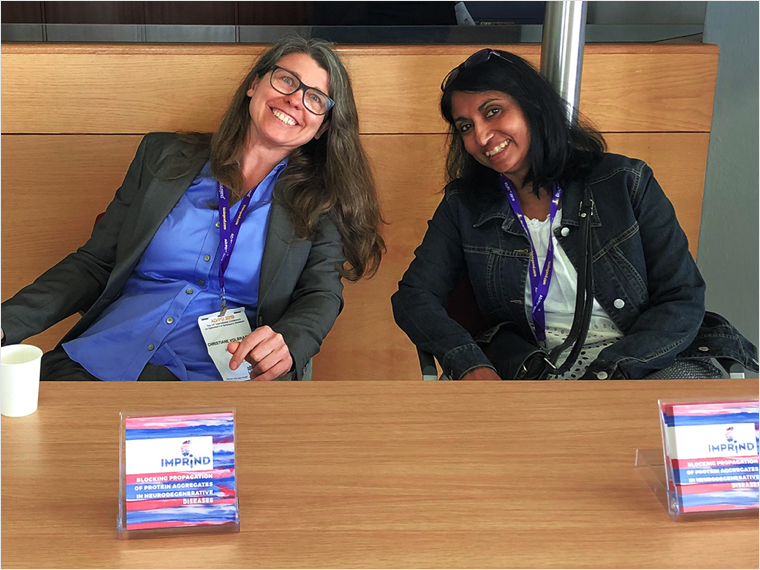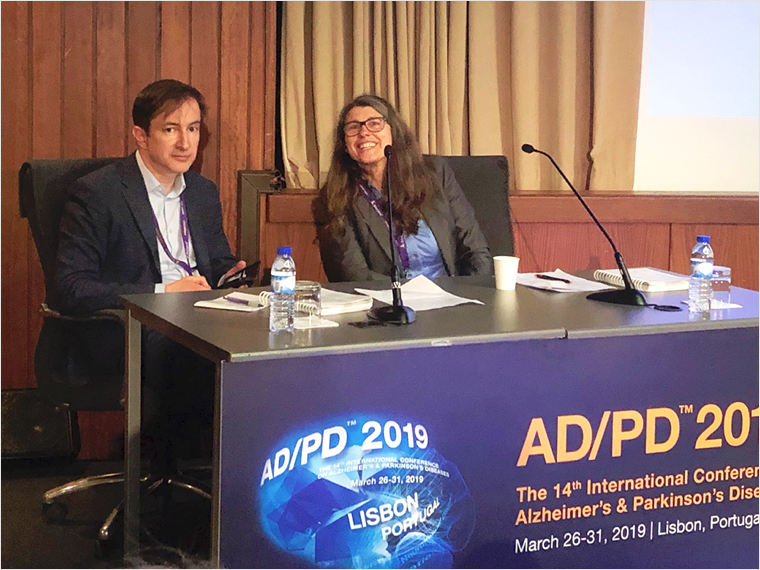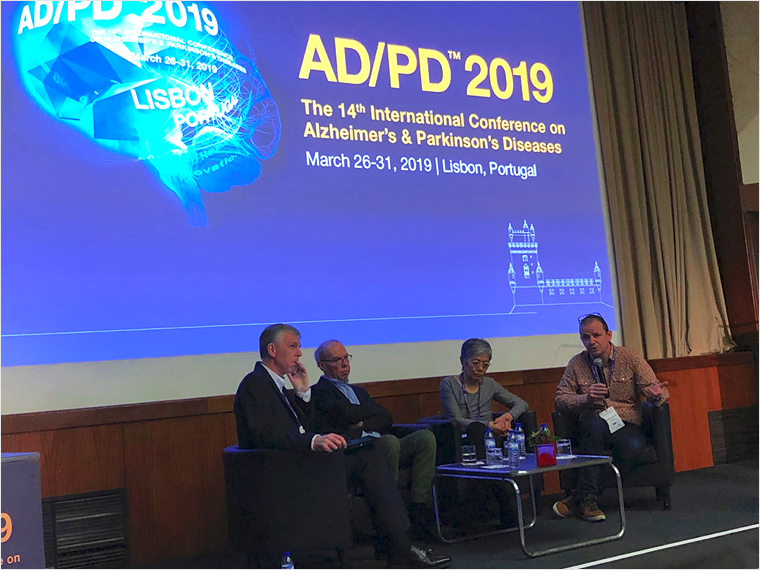The biochemical properties and cellular effects of proteopathic assemblies
14th International Conference on Alzheimer’s & Parkinson’s Diseases, AD/PD™ 2019
30th March 2019
17:15—19:15
30th March 2019
17:15—19:15
IMPRiND has organised its first Scientific Symposium on proteopathic assemblies during the 14th International Conference on Alzheimer’s & Parkinson’s Diseases, AD/PDTM 2019.
It was chaired by the coordinator of IMPRiND, George Tofaris (partner UOXF) and the project leader of IMPRiND, Christiane Volbracht (partner HLU). It included two speakers internal to the consortium: Michel Goedert (partner LMB) and Diederik Moechars (partner Janssen) and two external speakers: Virginia Lee from the Center for Neurodegenerative Disease Research, University of Pennsylvania, Philadelphia, USA and Dominic Walsh from the Deutsche Zentrum für Neurodegenerative Erkrankungen in Tübingen, Germany.
The presentations were followed by a panel discussion with questions from the audience. This proved to be an enjoyable and informative evening. There was a large number of attendees (>500) who engaged with the panellists during the questions time which lasted for one hour. Beyond the scientific debate, the symposium offered a platform to introduce the IMPRiND project and its objectives to the wider scientific community.
It was chaired by the coordinator of IMPRiND, George Tofaris (partner UOXF) and the project leader of IMPRiND, Christiane Volbracht (partner HLU). It included two speakers internal to the consortium: Michel Goedert (partner LMB) and Diederik Moechars (partner Janssen) and two external speakers: Virginia Lee from the Center for Neurodegenerative Disease Research, University of Pennsylvania, Philadelphia, USA and Dominic Walsh from the Deutsche Zentrum für Neurodegenerative Erkrankungen in Tübingen, Germany.
The presentations were followed by a panel discussion with questions from the audience. This proved to be an enjoyable and informative evening. There was a large number of attendees (>500) who engaged with the panellists during the questions time which lasted for one hour. Beyond the scientific debate, the symposium offered a platform to introduce the IMPRiND project and its objectives to the wider scientific community.
Agenda
Click on the title of each presentation to see its abstract.
ObjectivesThe commonality of many neurodegenerative disorders is the predictable temporal occurrence and progression of specific aggregated proteins in the brain. The hallmark proteopathy is Alzheimer’s disease (AD) in which the aggregation and seeded propagation of amyloid-β peptide (Aβ) triggers AD pathogenesis that includes neuronal Tau inclusions and neurodegeneration. A common strategy is therefore to develop reagents that inactivate proteopathic seed propagation.
Methods: Seed propagation and spreading was studied in experimental mouse models and AD brain. Reagents were tested that recognize native seeds and block seed propagation in vivo.
ResultsProteopathic seeds can spread within and among brain regions. The spreading of the disease is determined by the interaction of the seeds with the host. Reagents targeting seeds block disease progression in experimental mouse models.
Conclusion: Targeting proteopathic seeds at an early disease stage is a promising strategy.
The deposition of β-sheet rich amyloid aggregates formed by disease-specific proteins is a common feature of many neurodegenerative diseases and are believed to cause neuronal dysfunction directly or indirectly. Recent studies have strongly implicated cell-to-cell transmission of misfolded proteins through templated recruitment as a common mechanism for the onset and progression of various neurodegenerative disorders. Emerging evidence also suggests the presence of conformationally diverse “strains” for each type of disease protein, which may be another shared feature of amyloid aggregates, accounting for the tremendous heterogeneity within each category of diseases. In Alzheimer’s disease and other age-related tauopathies, the normally soluble tau protein accumulates as insoluble neurofibrillary tangles (NFTs) whereas in Parkinson’s disease and other related synucleinopathies, the highly soluble α-synuclein protein are converted to aggregated Lewy bodies (LBs) in neuron and glia. We have developed non-transgenic mouse models of tauopathies and synucleinopathies and have used them to test the “transmission” hypothesis and the “strain” hypothesis in order to elucidate mechanisms of progressive spread of NFTs and LBs as well as to explore the molecular basis of strain heterogeneity.
ObjectivesDetermination of the high-resolution structures of tau filaments from the brains of individuals with Alzheimer’s disease (AD) and Pick’s disease (PiD).
MethodsElectron cryo-microscopy (cryo-EM) and negative- stain immunogold electron microscopy (immuno-EM) were used.
ResultsPaired helical filaments (PHFs) and straight filaments (SFs) of AD are made of two identical C-shaped protofilaments that extend from G273/304-E380 (in the numbering of the 441 amino acid isoform of human brain tau). PHFs (the majority species) and SFs (the minority species) are ultrastructural polymorphs, because they differ in their inter-protofilament packing. To date, we performed cryo-EM on four cases and immuno-EM on 19 cases of AD. Narrow Pick filaments (NPFs) and wide Pick filaments (WPFs) are the tau filaments of PiD, a 3R tauopathy. NPFs make up over 90% of filaments. They extend from K254-F378 of 3R tau and are made of a J-shaped protofilament that differs from the AD protofilament. WPFs are formed by the association of two NPF protofilaments. Immuno-EM was used on 9 cases of PiD.
ConclusionsThere was no significant variation in tau filament structure between individuals with either AD or PiD. However, those structures were very different between AD and PiD, consistent with the existence of molecular conformers of aggregated tau.
ObjectivesA common feature in a variety of neurodegenerative diseases is the accumulation and toxic gain of function of misfolded assemblies of specific proteins. Alzheimer´s disease (AD) and Parkinson´s disease (PD) - the two most abundant forms of neurodegeneration – are respectively characterized by fibrils of hyperphosphorylated tau in intracellular neurofibrillary tangles (NFT) and aggregates of Aβ peptides in extracellular plaques or by α-synuclein fibrils that are the constituent of intraneuronal Lewy bodies (LB). More recently, it has been shown that assemblies of both tau or α-synuclein exhibit prion-like properties and spread through the central nervous system along interconnected neuronal networks suggesting that a unifying molecular mechanism may underpin the pathogenic progression in AD and PD. This prion-like propagation of pathology provides potential novel opportunities for therapeutic intervention that are currently being addressed in our group. An overview of these ongoing activities in our group will be presented.
MethodsA broad variety of as pathophysiologic relevant as possible in vitro and in vivo models of prion-like Tau propagation are being developed that in first instance allow addressing basic scientific questions in Tau propagation. Such models in second instance allow target identification, target validation and small and large molecule identification and screening of modulators of Tau propagation at the level of Tau seed uptake, Tau seed clearance, Tau protein level, Tau aggregate build up, Tau aggregate clearance and Tau spreading.
Results & ConclusionsThis presentation will review the current state of development of therapeutic interventions based on prion-like propagation Tau of pathology and will discuss progress towards.
This project receives funding from the Innovative Medicines Initiative 2 Joint Undertaking (www.imi.europa.eu) under grant agreement No 116060. This Joint Undertaking receives support from the European Union’s Horizon 2020 research and innovation programme and EFPIA.
This work is supported by the Swiss State Secretariat for Education‚ Research and Innovation (SERI) under contract number 17.00038.
The opinions expressed and arguments employed herein do not necessarily reflect the official views of these funding bodies.






